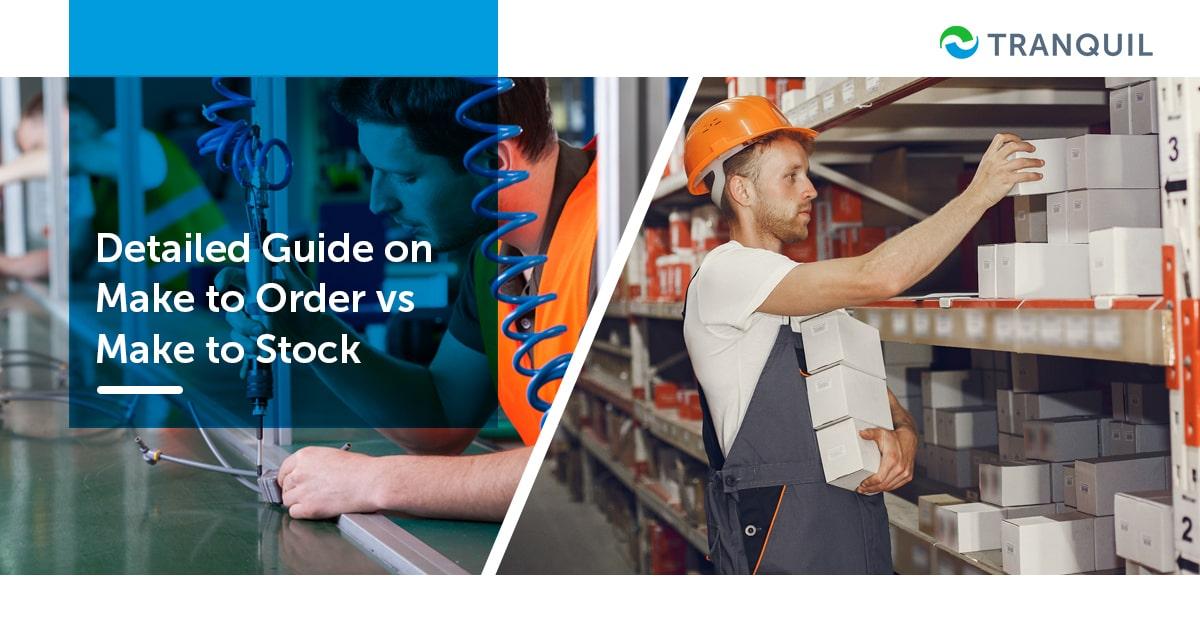
As a manufacturing business, you need to choose the production methodology that is best suited for your specific business – mainly the type of product you manufacture, your facility capacity, and so on.
There are several types of production processes from which you can choose:
The most commonly used processes are make-to-order and make-to-stock.
So here we will examine these two processes in detail, and the differences between them.
This can help you make a decision about which process is most suited for your manufacturing business.

Also referred to the pull-type production method, make-to-order manufacturing refers to the process of getting orders from customers first and producing sufficient quantities to meet those consumer demands.
This can be followed in processes which are reasonably quick.
In one way, it is similar to the engineer to order process, as the product can be customized as per customer specifications.
This helps to avoid wastage and ensures no holding inventory.
It is suited for industries like food – for example, a catering business; the fashion industry, skincare, bags, and so on.
It is also suitable for industries who produce raw materials – for example, say cement, or steel bars.
Assembled computers are also another example of this model of Obviously, it won’t work for industries where it takes weeks or months for the product to be manufactured.
However, lead times will be longer for processes like manufacturing and shipping, these products are also not manufactured on a large scale, so the final product could be more expensive.
ALSO READ: Guide on Stock Adjustment and Stock Transfer

Make-to-order products, as we have seen, are usually produced for specialized industries which could need specifications that are not found anywhere else.
Due to this and the variety of raw materials that need to be stocked, it is important that make to order production businesses implement a robust inventory management system like the one from Tranquil.
An automated inventory management system can help manufacturers to effectively track all raw materials and orders.
Barcode scanners and the bill of materials feature can help manufacturers to track products with just a click.
They can also assign the components required to assemble the MTO product precisely to ensure smooth and uninterrupted production.
Reducing waste does not mean just cutting down expenses on the disposal of materials.
With this process, you only need to spend on what is necessary for your production, and that too, those that benefit your customers.
Any product addition, process, or action is considered wasteful if it does not provide value for the customer.
As manufacturing is strictly as per the customer’s order and commenced after receiving the order, it is possible to manufacture products with maximum efficiency.
You will need to determine however when you will start production – either by choosing forward or backward scheduling.
Customers who want a personalized shopping experience will seek you out, rendering your products unique, as compared with make-to-stock companies.
ALSO READ: Guide on How Do ERP Systems Work
Every business has cyclical demand for products, with peaks and slumps; during festival seasons, you may have sudden spikes in demand, which can put a strain on your processes.
By its nature, a make-to-order business has to be ready for the next order so that production can begin as quickly as possible.
However, if your stock levels are not accurately recorded or read, you run the risk of being out of raw materials at crucial times, which means lagging behind on orders.
Customers are not willing to wait for a long time for their products; with MTP, lead times are longer, and this could result in unhappy customers.
Of course, they do know that they have to wait, but if the waiting time goes beyond what they expected originally, it will result in dissatisfaction.
That was about the make-to-order process.
Now let us look at the other option.
ALSO READ: Important ERP Modules and Functions

The make-to-stock process is all about producing goods depending on anticipations of demand from consumers.
Products are stocked for sales likely to happen in the future, and not for those that have already taken place during production; these are kept ready for distribution in warehouses.
Forecasts and real-time data help manufacturers in determining the correct quantity of products to be manufactured and help to reduce wastage.
It is the ideal production method for complex products which take a longer time to manufacture – for example, cars, machinery, and similar.
It is also the most commonly used process of production.
Of course, it involves handling and storing substantial inventory stocks, so lean production is not really possible.
Now as you can see, this method is the complete opposite of the MTO process, where the products are manufactured based on actual demand, or the pull-type model.
On the other hand, the make-to-stock production method is a push-type model as the products are pushed into production anticipating sales.
This method relies heavily on the accuracy of sales forecasts.
If that is not accurate, you could end up with excess inventory, and lose revenue because of carrying costs, theft, damage, or spoilage of materials or products.
For example, in anticipation of the sales of TVs spiking just before the Olympics, an electronics manufacturer may decide to double their production.
Now here the company is basing its inventory on anticipation and prediction and not actual demand – and that is make to the stock method.
There is always the risk that the demand may fall short of the predicted figure.
ALSO READ: Inventory Management Challenges and How Best to Solve them
As the make-to-stock production process relies heavily on forecasts, trends, and historical data, it is imperative that you install an automated inventory management system that allows efficient tracking of inventory.
From the time it is purchased till it is received, inventory must be tracked meticulously so that it does not get misplaced in production.
Tracking raw materials throughout the production life-cycle is critical as it facilitates the implementation of a seamless transaction flow through the whole system.
Features for vendor management enable make to stock manufacturers to systematically organize their products.
The features may include elements like vendor part numbers, lead times, multiple vendors per item, costs, and so on.
With a powerful ERP like Tranquil, the possibility of human error is greatly reduced.
You can also ensure that you don’t miss opportunities that present themselves in your supply chain.
Tranquil is a cloud-based ERP software and its robust Inventory Management and Production Management modules can help make production planning and maintenance smooth and simple, and offer greater visibility into purchasing, production, warehousing, and so on.

Depending on the type of your business and the products, make-to-stock can be a viable production method for you.
Let us first look at the benefits it offers:
Here you manufacture products in anticipation of consumer demand, and this allows you to allocate resources more carefully.
Production can therefore be performed to ensure maximum efficiency.
With this method, you will be able to create a master schedule of production, ensuring the smoothest possible workflows.
This way, everyone knows where each one has to be, what tasks remain to be carried out, or what milestones are still to be met.
ALSO READ: Difference Between Procurement And Purchasing
In MTS production, your products wait for your customers instead of the other way around as it is in the MTO system.
Products can be shipped to customers as soon as customers place orders.
This means minimal wait time for customers.
The make to stock method is perfect for manufacturers who exercise full control over their business workflows and who value organization.

As with anything, this method has got its own drawbacks; so let us take a look at what those disadvantages are:
One can never predict or forecast with 100% accuracy regarding consumer demand – no matter whether you are using the best software, or you have studied historical trends and seasonal demand surges for the past few years.
Many unknowns are there – the best example is the COVID 19 pandemic – which can throw all calculations out of year.
And you may end up not selling anything close to what you expected.
This means excess inventory, and higher chances of damage, wastage, theft, and obsolescence.
Or it could also happen, that there is an unexpected surge in demand and you are not prepared for it.
Being stocked out means unhappy customers!
ALSO READ: Detailed Guide to Point-of-Sale Systems
You always run the risk of carrying too much inventory or insufficient inventory. It’s just the nature of this methodology.
Business is a complex thing and can be impacted by a multitude of variables, most of them completely out of your control.
This can make forecasting sales very difficult.
And on top of it, even if you make a tiny mistake, you could end up with excess inventory or get stocked out – costing your business heavily.
Each methodology has its own set of advantages and disadvantages.
It may not be easy to decide which method you should follow, and which will be ideal for you.
However, it is not something written in stone, so you can experiment with both methods and see which one suits your business better.
You can switch between the two even.
Whatever you choose, you will still need to do a lot of hard work!
However, if implemented properly, you can ensure smooth, uninterrupted production and minimal wastage or delays.
ALSO READ: What Are the Stages of Fixed Asset Lifecycle?
Final Thoughts
Whether you choose to make to stock or make to order, you need a robust ERP system like Tranquil that has efficient and customizable modules for production management and inventory management.
These features will help you take your production efficiency to the next level, and give you the competitive edge you always wanted.
Tranquil ERP is a cloud-based system that helps in the automation and streamlining of all the departments or processes in an organization. To see how it works and how it can help in the efficient tracking and management of inventory and smooth production, do schedule a demo with us. We will be happy to explain everything and answer your queries.